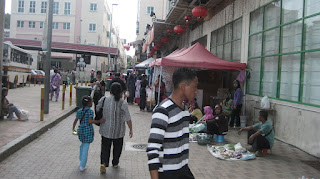
During the early 1870s, the east coast of Sabah was under control of the Sultan of Sulu, who also ruled what is now the southern Philippines. The first European settlement in the area was founded by William Clarke Cowie, a Scottish gun smuggler from Glasgow, who received permission from the Sultan to establish a small trading base. Cowie called his settlement Sandakan, which in (Sulu) language means "the place that was pawned", but it soon came to be known as "Kampung German" after the large number of Germans who also set up posts there. The settlement was part of the lease Austro-Hungarian consul Baron von Overbeck acquired from the Sultan of Sulu in 1878. After the lease was purchased by von Overbeck's British partner Alfred Dent, Kampong German was accidentally razed to the ground on 15 June 1879. The new British Resident, William Burges Pryer, decided not to rebuild the village but to move to (what is now called) Buli Sim Sim on 21 June 1879.[1] He named his new settlement Elopura, which means Beautiful City. A few years later, the name reverted back to Sandakan. The name Elopura still refers to a Sabah state constituency in Sandakan.

In 1883, the capital of the British North Borneo Company was moved from Kudat to Sandakan. In the mid-1930s, Sandakan's timber export reached the record figure of 180,000 cubic meters, making it the largest timber-exporting port of tropical hardwood in the world. At the height of the timber boom, Sandakan boasted that it had the highest concentration of millionaires anywhere on Earth.
The Japanese occupation of Sandakan during World War II began on 19 January 1942 and lasted until a brigade of the Australian 9th Division liberated it on 19 October 1945. The Japanese administration restored the name Elopura for the town. One of the atrocities of World War II was the Sandakan Death Marches, when Japanese soldiers decided to move about 2,400 prisoners of war in Sandakan 260 km (160 miles) inland to the town of Ranau. The prisoners who did not die en route to Ranau were crammed into unsanitary huts; most of those survivors either died from dysentery or were killed by prison guards. When the war ended, Sandakan was totally destroyed, partly from the Allied bombings and partly by the Japanese. As a result, when North Borneo became a British Crown Colony in 1946, the capital was shifted to Jesselton, now known as Kota Kinabalu, (often just called 'KK' locally).
Sandakan remains Sabah's second most important port, after Kota Kinabalu. The port is important for palm oil, tobacco, cocoa, coffee, manila hemp and sago exports. Sandakan is also one of the most bustling towns in East Malaysia. The once dominant timber industry is now relatively small. It is likely tourism will become increasingly important to the town's future.
In recent years, businesses have shifted their operations away from the town centre to the suburbs (Bandar Ramai-Ramai, Bandar Leila, Bandar Nam Tung, Bandar Maju, Bandar Kim Fung, Bandar Pasaraya, Bandar Letat, Bandar Indah Jaya, Bandar Utama, Bandar Perdana, Bandar Labuk Jaya, Bandar Sibuga Jaya, etc.) due to the presence of significant illegal immigrants in the town centre. In January 2003, the Sandakan Harbour Square, an urban renewal project, was launched in an attempt to revive the town centre as the commercial hub in Sandakan. It will feature extra shoplots, a new central market and fish market, a shopping mall (Sandakan Harbour Mall), and hotels. It is to be built in four separate phases and is due for completion in 2011.















No comments:
Post a Comment